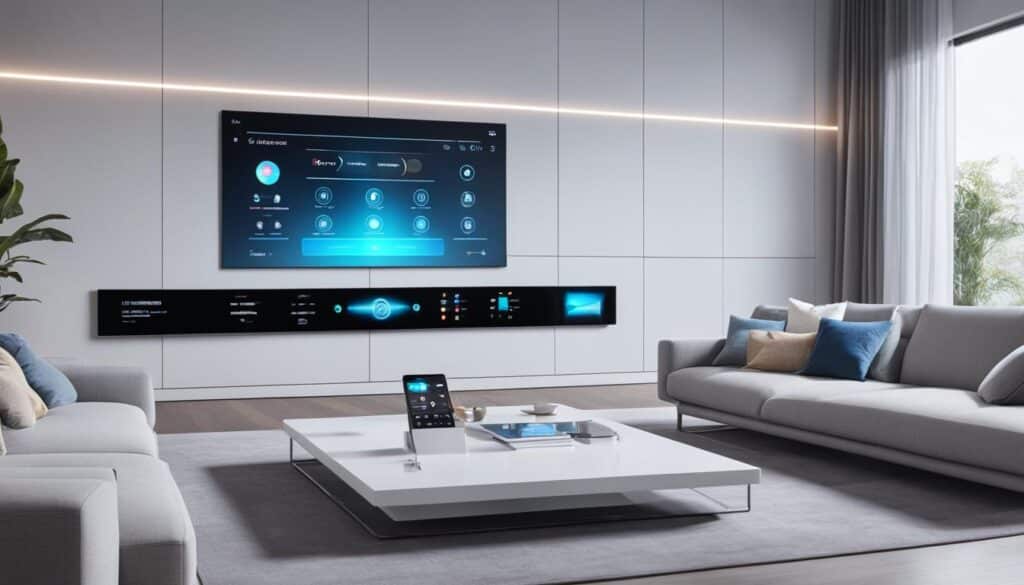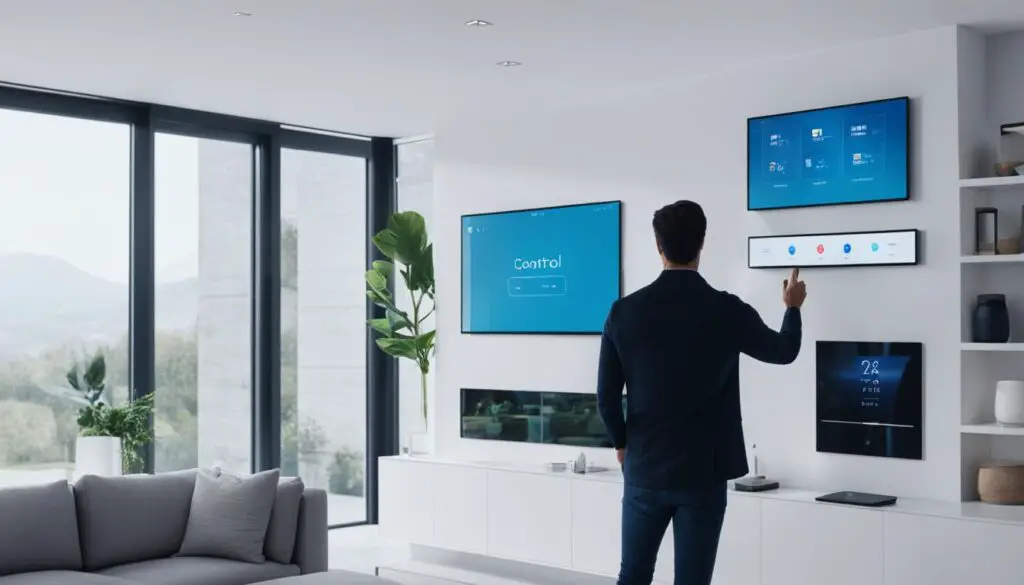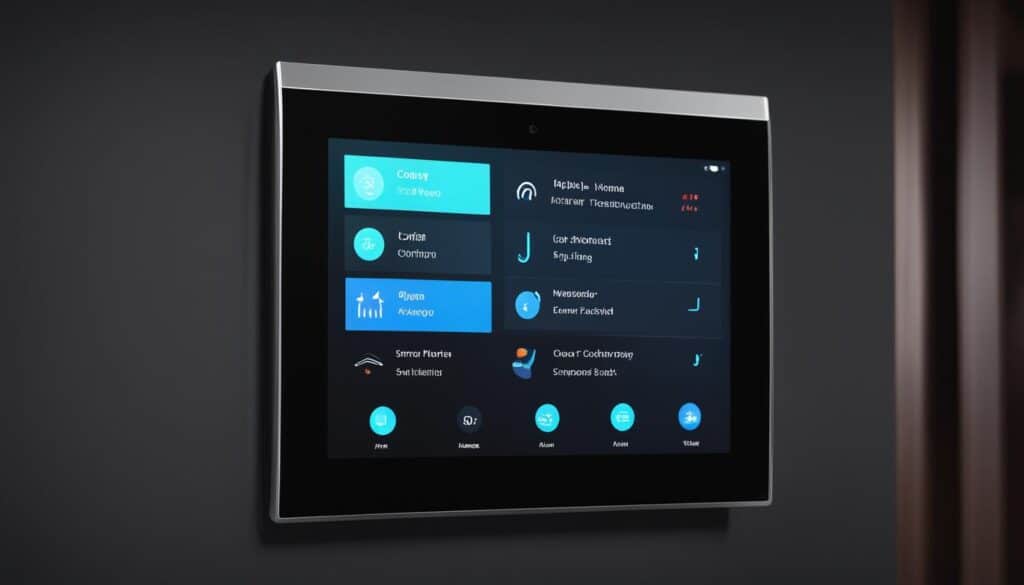Greetings, fellow home enthusiasts! Today, I’m here to take you on an exciting journey into the world of smart home control panels. Whether you’re a complete beginner or just looking to deepen your understanding, this tutorial is here to guide you every step of the way.
Smart home control panels are the heart and soul of a connected and automated living space. They bring together all your smart devices, allowing you to manage and control them effortlessly. Imagine being able to adjust your home’s lighting, temperature, and security system with just a few taps on a screen or even a simple voice command. It’s like having a personal assistant at your beck and call, making your home smarter and your life easier.
In this beginner’s tutorial, we will unravel the mysteries behind smart home control panels. We’ll discuss their different types, how they work, and the remarkable benefits they offer to homeowners like you. Whether you’re considering setting up your first smart home system or looking to upgrade your existing one, this tutorial will equip you with the knowledge and confidence to make informed decisions. So, let’s embark on this exciting adventure together!
Table of Contents
Key Takeaways:
- Smart home control panels are essential for creating a connected and automated living space.
- They allow you to manage and control various smart devices from a centralized hub.
- Control panels come in different types, including touchscreen panels, voice-enabled panels, and mobile apps.
- Communication protocols like Wi-Fi, Zigbee, and Z-Wave enable control panels to connect with other smart devices.
- Smart home control panels offer features like automation, convenience, energy efficiency, and enhanced security.
What are Smart Home Control Panels?
Smart home control panels are essential devices that act as centralized hubs for managing and automating various aspects of a smart home system. These panels provide a user-friendly interface, allowing homeowners to conveniently control and monitor different devices and systems within their home. Whether standalone devices or integrated into other devices like smart speakers or touchscreens, smart home control panels offer seamless communication and control by connecting to other smart home devices via wireless protocols such as Wi-Fi, Zigbee, or Z-Wave.
With smart home control panels, homeowners have the power to control features like lighting, thermostats, security systems, and entertainment systems, all from a single interface. These panels enable effortless automation and customization, making it easier than ever to create personalized experiences and enhance the overall functionality and efficiency of a smart home. From adjusting room temperatures to setting the perfect ambiance, smart home control panels provide the ultimate convenience and control over one’s living space.
Smart home control panels bring the power of automation into the hands of homeowners, simplifying tasks and streamlining daily routines. Whether it’s turning off lights automatically when a room is unoccupied, adjusting temperature settings based on occupancy patterns, or remotely monitoring security cameras, these panels make it possible to create a truly smart and connected home.
Stay tuned to learn more about the different types of smart home control panels and how they work!
Types of Smart Home Control Panels
When it comes to smart home control panels, there are several options available to suit different user preferences and needs. Let’s explore the different types of control panels and their unique features and benefits:
1. Touchscreen Control Panels
Touchscreen control panels feature a visual interface that allows users to interact directly with the device using gestures or taps on the screen. These panels provide a more intuitive and immersive control experience. With a simple touch, users can adjust settings, control devices, and access various smart home features.
2. Voice-Enabled Control Panels
Voice-enabled control panels, such as smart speakers with built-in virtual assistants like Amazon Alexa or Google Assistant, enable users to control their smart home devices using voice commands. By simply speaking a command, homeowners can dim the lights, adjust the thermostat, or play music, creating a hands-free control experience.
3. Mobile Apps
Mobile apps serve as convenient control panels for smart homes, allowing users to control their devices remotely from their smartphones or tablets. These apps provide an easy-to-use interface that enables homeowners to manage and automate their smart home system from anywhere. Whether you’re at work or on vacation, you can control your lights, security system, and other smart devices with a few taps on your mobile device.
Each type of control panel offers unique benefits, and the choice ultimately depends on individual preferences and requirements. Some users may prefer the tactile interface of a touchscreen control panel, while others might find the convenience of voice commands more appealing. Mobile apps provide flexibility and accessibility for those who are always on the go. Regardless of the type chosen, smart home control panels are designed to simplify and enhance the overall smart home experience.
Now that we’ve explored the different types of smart home control panels, let’s delve into how these panels work and the communication protocols they utilize.
How Smart Home Control Panels Work
Smart home control panels function as the central hub for managing and automating various smart devices within a home. To understand how these panels work, we need to explore the communication protocols and device integration involved.
Communication Protocols:
Smart home control panels establish connections with devices through communication protocols like Wi-Fi, Zigbee, or Z-Wave. These protocols enable the control panel to exchange information and commands with the connected devices, allowing for seamless control and automation.
Device Integration:
Control panels act as intermediaries, translating user commands into instructions that devices can understand and execute. They receive feedback from the devices, providing real-time status updates and notifications to the user.
Furthermore, control panels support device integration, which enables users to create custom scenarios and automation routines by linking different devices together. This integration allows for more advanced and personalized control over a smart home system.
| Function | Description |
|---|---|
| Communicate | Control panels establish connections with smart home devices through communication protocols like Wi-Fi, Zigbee, or Z-Wave. |
| Translate | Control panels act as intermediaries, translating user commands into instructions that devices can understand and execute. |
| Feedback | Control panels receive feedback from devices, providing real-time status updates and notifications to the user. |
| Integrate | Control panels support device integration, allowing users to create custom scenarios and automation routines by linking different devices together. |
With the ability to communicate, translate, provide feedback, and integrate devices, smart home control panels enhance the overall user experience and make it easier to manage and control a connected home.

By acting as the central command center, smart home control panels bring convenience, efficiency, and customization to our fingertips. In the next section, we’ll explore the features and benefits that these control panels offer homeowners.
Features and Benefits of Smart Home Control Panels
Smart home control panels offer a wide range of features and benefits that enhance the overall smart home experience.
Automation: Control panels enable automation by allowing users to create schedules, routines, and scenes that automate different devices based on specific triggers or events. This automation saves time and effort and enhances energy efficiency by optimizing the use of devices.
Convenience: With control panels, users can control multiple devices from a single interface, providing convenience and ease of use. They no longer need to manage each device individually, as the control panel acts as a central hub for device control.
Enhanced Security: Control panels integrate with security systems, allowing users to monitor and control their home’s security features. Users can receive real-time alerts, view security camera feeds, and lock or unlock doors, enhancing the security of their smart home.
Centralized Control and Monitoring: Control panels provide a centralized hub for controlling and monitoring different aspects of a smart home system. Users can access and manage all connected devices from a single interface, ensuring complete control and peace of mind.
By incorporating smart home control panels into your home, you can enjoy the benefits of automation, energy efficiency, convenience, and enhanced security.
| Features | Benefits |
|---|---|
| Automation | Saves time and effort |
| Enhances energy efficiency | |
| Convenience | Control multiple devices from a single interface |
| Enhanced Security | Integrates with security systems for real-time monitoring and control |
| Centralized Control and Monitoring | Complete control and peace of mind |
Choosing the Right Smart Home Control Panel
When it comes to creating a smart home system, choosing the right control panel is crucial. The control panel serves as the central hub that connects and manages all your smart devices. In this section, I will guide you through the key factors to consider when choosing a smart home control panel.
Compatibility
Compatibility is paramount when selecting a control panel for your smart home. You want to ensure that the control panel can seamlessly communicate and integrate with your existing smart devices. This compatibility will allow you to have full control and automation over your entire smart home system. Before making a purchase, check the control panel’s compatibility specifications and make sure it supports the devices you already have or plan to add to your network.
Scalability
When investing in a control panel, it’s essential to think about the future. A scalable control panel will allow you to expand your smart home system as your needs and preferences evolve. Look for control panels that offer the ability to add new devices and features without limitations. This scalability will provide you with the flexibility to adapt your smart home system to suit your changing lifestyle.
User Interface
The user interface (UI) of the control panel plays a significant role in your overall smart home experience. You want a control panel with an intuitive and user-friendly UI that makes it easy for you to navigate and control your smart devices. The UI should be accessible for users of all ages and technological expertise levels. Consider control panels with touchscreen displays, voice control features, or mobile app integration, depending on your preferences and convenience.
“Choosing the right control panel is like finding the perfect conductor for your smart home orchestra. It orchestrates the seamless integration and control of all your smart devices.”
To help you visualize the factors to consider when choosing a control panel, take a look at the table below:
| Factor | Importance | Control Panel A | Control Panel B | Control Panel C |
|---|---|---|---|---|
| Compatibility | High | ✓ | ✓ | ✓ |
| Scalability | Medium | ✓ | ✓ | ✓ |
| User Interface | High | ✓ | ✓ | ✓ |
| Voice Control | Medium | ✓ | ✓ | ✓ |
Remember, choosing the right control panel is a personal decision. Evaluate your specific needs, consider the factors mentioned above, and find the control panel that best aligns with your requirements. The right control panel will serve as the heart of your smart home, making your automation dreams a reality.

Conclusion
Smart home control panels are essential tools for managing and automating various aspects of your smart home system. By understanding the different types of control panels, how they work, and their features and benefits, you can make informed decisions when transforming your living space into a connected and automated environment.
With smart home control panels, you can enjoy the convenience of controlling multiple devices from a single interface. Whether it’s adjusting the lighting, setting the temperature, or managing your entertainment system, everything is just a tap or voice command away.
Furthermore, smart home control panels offer energy efficiency by allowing you to create automation routines and schedules that optimize the use of your devices. This not only helps you save on energy bills but also minimizes your environmental impact.
In addition to convenience and energy efficiency, smart home control panels enhance the security of your living space. By integrating with security systems, you can monitor and control your home’s security features, such as locks, cameras, and alarm systems.
Transform your living space into a smart home and experience the benefits of a more efficient, convenient, and secure environment. Incorporate smart home control panels into your home and unlock the full potential of a connected and automated lifestyle.
FAQ
What is a smart home control panel?
A smart home control panel is a centralized hub that allows homeowners to control and automate various devices and systems within their smart home. It provides a user-friendly interface and connects to smart home devices via wireless protocols, enabling seamless communication and control.
What are the different types of smart home control panels?
There are several types of smart home control panels available. These include touchscreen control panels, voice-enabled control panels (such as smart speakers), and mobile apps that allow users to control their smart home devices from their smartphones or tablets. Each type offers unique features and benefits.
How do smart home control panels work?
Smart home control panels establish a connection with smart home devices through communication protocols like Wi-Fi, Zigbee, or Z-Wave. They act as intermediaries, translating user commands into instructions that the devices can understand and execute. Control panels also receive feedback from the devices, providing real-time status updates and notifications.
What are the features and benefits of smart home control panels?
Smart home control panels offer automation, allowing users to create schedules, routines, and scenes that automate different devices based on specific triggers or events. They also provide convenience by allowing users to control multiple devices from a single interface and remotely manage their smart home system. Additionally, control panels enhance security by integrating with security systems and offering centralized control and monitoring.
How do I choose the right smart home control panel?
When choosing a smart home control panel, it’s important to consider factors like compatibility with your existing smart home devices, scalability to accommodate future expansions, and the user interface that suits your preferences. Compatibility ensures seamless communication and integration, while scalability allows for future additions. The user interface should be intuitive and user-friendly.


